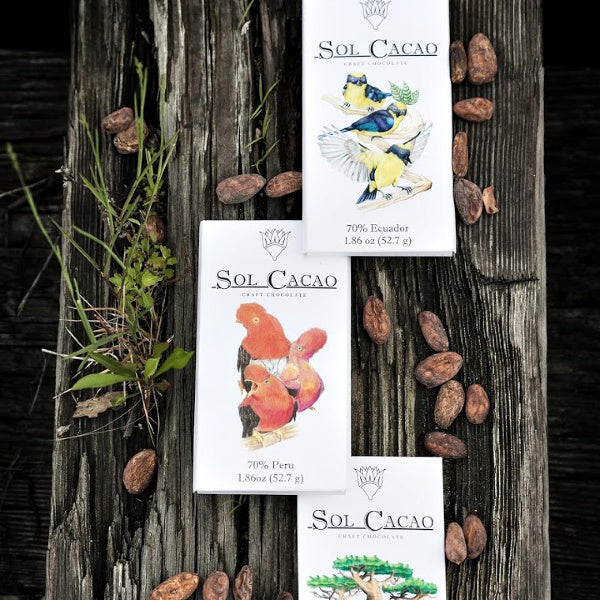Photo: Sol Cacao
We came for the love and stayed for the chocolate on Valentine’s Day.
The Valentine’s Day holiday actually has a rather inauspicious history. There are two prevailing theories about what started it all, and neither involves Hallmark. One is that the wild pagan, possibly pre-Roman festival of Lupercalia (name derived from the Latin name of a Roman god of the flocks), an event in which men were stripped naked and spanked by young women in a bid to increase their fertility started it all. The other is that the holiday honors St. Valentine, who defied Roman Emperor Claudius II’s order forbidding young men from marrying (the Emperor believing unmarried men made better soldiers) to marry couples and was executed for his trouble on February 14th.
Either way, the holiday has been celebrated for centuries; in its modern form, for at least 600 years. The oldest record of a Valentine’s Day card dates back to 1415, when Charles, Duke of Orleans, wrote one to his wife during his imprisonment in the Tower of London.
While peppermint hearts, flowers, and declarations of crush/love are still a thing, both men and women vastly prefer to receive chocolate on Valentine’s Day, according to the National Confectioners Association, which reported that a resounding 94% of Americans believe chocolate and candy make Valentine’s Day more fun and that chocolate sales represent 75% or more of Valentine’s Day candy purchases.
Unfortunately, not all chocolate is created equal. And we’re not just talking about taste. We are talking about what happens behind the scenes at cocoa farms.
We sat down with Daniel, one of the trio of brothers behind free-trade, organic, bean-to-bar chocolate producer Sol Cacao, based in the Bronx, to find out more about the issues facing the industry at large, and what they and other choco-activists are doing to make our favorite confection anything but a guilty pleasure.
New York Makers: Why is being fair-trade and organic such a big deal in the chocolate industry?
Daniel Maloney: There are a lot of issues facing the chocolate industry. The average cacao farmer doesn’t make a living wage, despite working very, very hard [EDIT: estimates vary, but most farmers reportedly make less than $1 a day in certain regions], there are child labor issues [one study conducted by Tulane University revealed more than 1.8 million children working on cocoa farms in Ghana and the Ivory Coast alone], there are serious environmental challenges [the Ivory Coast alone has lost more than 80% of its forests in the last 50 years to cocoa production]. Certified organic and fair-trade chocolates are produced ethically and in an environmentally sustainable way. You can feel good about eating these chocolates.

Photo: Sol Cacao
NYM: Why did you and your brothers personally feel the need to prioritize these issues?
DM: My brothers and I grew up in the Caribbean islands of Trinidad and Tobago, surrounded by cacao trees and eating chocolate directly from the trees. Cacao and chocolate are an inherent part of Caribbean culture. When we came to the U.S. as children, we found the chocolate here was not like it was back in the Caribbean. So as we settled in Brooklyn, and then in Connecticut, went to high school and college, my brothers and I always had chocolate on the brain. We also discovered growing up that our grandparents were cacao farmers, so the business of chocolate felt even more personal. We wanted to find a way to bring the quality we remember from our childhood here, and we knew part of ensuring the quality involved being able to trace the source of the beans, and make sure the farmers and everyone along the way got compensated fairly.
NYM: That’s quite an undertaking. How did you go about it?
DM: It has been a nine-year journey. We knew that to achieve the results we wanted we needed to start with really good ingredients, and we needed to understand the science of chocolate making. We spent three years just studying chocolate, and then we began experimenting with making the chocolate, and then we finalized the sources and pulled together the capital. We launched in 2016 unofficially, but it wasn’t until 2019 that we really stabilized. We have a good situation at a factory in the South Bronx, and we have naturally fallen into roles over the years, even though we all do a bit of everything. My eldest brother Dominic, who’s 31, is the chocolatier. My middle brother Nicholas, who’s 30, gravitated toward the sales, and I handle the operational end.

Photo: Sol Cacao
NYM: Tell us about the chocolate and the choices you made.
DM: We wanted to focus on the differences between chocolate, depending on where it’s grown. Like wine or coffee, chocolate changes dramatically from region to region, but most people never have the opportunities to taste Madagascar chocolate and compare it against chocolate from Peru. In the end, we decided to highlight three different regions that we believe are completely different. We have a Madagascar chocolate, which is very fruit-forward, with red berry notes; an Ecuadorian chocolate, which is nuttier and has an almost whiskey-like flavor; and a Peruvian chocolate, which tastes like oak-barrel Chardonnay -- there are floral notes, and it’s delicate. We have three bars, all made just from cacao and cane sugar. The ingredients are simple so that we can let the complex flavors shine.

This year, on Valentine’s Day and beyond, make sure you follow your heart in every way. And don’t forget to include the chocolate! You can snag bean-to-bar Sol Cacao here.


Leave a comment